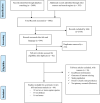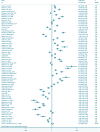A systematic review and meta-analysis of the prevalence of parasitic infections in equids in Ethiopia
- PMID: 37520199
- PMCID: PMC10382411
- DOI: 10.1007/s12639-023-01598-3
A systematic review and meta-analysis of the prevalence of parasitic infections in equids in Ethiopia
Abstract
We performed this review to determine the weighted prevalence of equids parasitic infections in Ethiopia. Article searches on parasites of equids were conducted using PubMed, PubMed Central, Google Scholar, Science Direct, Web of Sciences, Scopus, AJOLs and Research Gate. A random effects model was used to estimate the weighted prevalence and to study heterogeneity. The primary searches generated, 3082 potential studies, of which 66 reports met the inclusion criteria and were included in the meta-analysis. There were 32 reports involving two or more equids species, eighteen on donkeys, and sixteen on horses. Moreover, fifty of the reports mentioned helminth infections in equids, thirteen on protozoans, and three on ectoparasites. The estimated weighted prevalence of parasitic infections in equids was 58.3% (95% CI 50.8-65.4%, I2 = 99%). Helminths were the most prevalent parasites in equids, accounting for 77.1% (95% CI 71.4%, 82%, I2 = 98.5%), followed by ectoparasites at 35.4% (95% CI 33.4-37.52%, I2 = 88.2%) and haemoparasites (protozoans) at 10.84% (95% CI 6.6%, 17.3%, I2 = 98.1%). Furthermore, with a prevalence of 82.3% (95% CI 75.9-87.3%, I2 = 97.4%), donkeys were the most affected equids with helminth parasites. From the reports, we found forty-three species of helminth parasites affecting equids, including thirty-four nematode species (Strongylus, Cyathostomum, Coronocyclus, Cylicocyclus, Cylicostephanus, Trichostrongylus, Oesophagodontus, Strongyloides, Triodontophorus, Gyalocephalus, Poteriostomum, Dictyocaulus, Oxyuris, Habronema, Draschia, Parascaris, Setaria, and Probstmayria species), three trematodes (two Fasciola and one Gastrodiscus species), three cestodes (two Anoplocephala and one Anoplocephaloides species) and three botfly larvae (one Rhinoestrus and two Gasterophilus species). Trypanosoma species (T. congolense, T. vivax, T. brucei, T. equiperdum, and T. evansi), piroplasms (Theileria equi and Babesia caballi), and Eimeria species have also been reported to affect equids. Ticks (Amblyomma variegatum, A. gemma, Rhipicephalus decoloratus, R. evertisi evertisi, R. pulchellus, R. muhsame, R. sanguineus, Hyalomma rufipes, and Hy. truncatum) and lice (Bovicola equi and Haematopinus asini) were the ectoparasites recorded to affect equids. The risk of publication bias across studies was likely to be high due to differences in publication year and diagnostic techniques. In conclusion, parasitic infections of equids are common in Ethiopia and are caused by a variety of parasite species, putting the performance and well-being of these packing animals at risk. Therefore, more research is needed to identify infection risk factors and raise awareness of the consequences of parasitism in order to provide strategies to mitigate the problems in equids.
Supplementary information: The online version contains supplementary material available at 10.1007/s12639-023-01598-3.
Keywords: Equids; Ethiopia; Meta-analysis; Parasites; Prevalence; Systematic review.
© Indian Society for Parasitology 2023. Springer Nature or its licensor (e.g. a society or other partner) holds exclusive rights to this article under a publishing agreement with the author(s) or other rightsholder(s); author self-archiving of the accepted manuscript version of this article is solely governed by the terms of such publishing agreement and applicable law.
Conflict of interest statement
Conflict of interestThe authors declare no competing interests.
Figures








Similar articles
-
Gastrointestinal parasites of working donkeys of Ethiopia.Trop Anim Health Prod. 2010 Jan;42(1):27-33. doi: 10.1007/s11250-009-9381-0. Epub 2009 Jun 23. Trop Anim Health Prod. 2010. PMID: 19548106
-
Prevalence of endo- and ecto-parasites of equines in Iran: A systematic review.Vet Med Sci. 2021 Jan;7(1):25-34. doi: 10.1002/vms3.321. Epub 2020 Jul 9. Vet Med Sci. 2021. PMID: 32644306 Free PMC article.
-
[Parasitic helminths of the cecum and colon of equidae in Italy].Parassitologia. 1992 Dec;34(1-3):53-60. Parassitologia. 1992. PMID: 1339978 Italian.
-
Parasitic diseases of equids in Iran (1931-2020): a literature review.Parasit Vectors. 2020 Nov 19;13(1):586. doi: 10.1186/s13071-020-04472-w. Parasit Vectors. 2020. PMID: 33213507 Free PMC article. Review.
-
Prevalence and risk factors associated with donkey gastrointestinal parasites in Shashemane and Suburbs, Oromia Region, Ethiopia.Heliyon. 2022 Dec 12;8(12):e12244. doi: 10.1016/j.heliyon.2022.e12244. eCollection 2022 Dec. Heliyon. 2022. PMID: 36578399 Free PMC article.
References
-
- Addis H, Gizaw TT, Minalu BA, Tefera Y. Cross-sectional study on the prevalence of equids strongyle infection in Mecha Woreda, Ethiopia. Int J Adv Res Biol Sci. 2017;4(8):68–77. doi: 10.22192/ijarbs.2017.04.08.011. - DOI
-
- Adeba A, Kassa T, Teshale A. The Occurrence of gastro intestinal parasites of donkeys in and around Holeta Town, Oromia Regional State. Ethiopia Adv. 2022;3(3):73–80. doi: 10.11648/j.advances.20220303.15. - DOI
-
- Alaba BA, Omoniwa DO, Olajide EO, Koleosho SA, Olaleye JT. Prevalence of haemoparasites and influence on haemato-biochemical parameters of polo horses in Ibadan, Nigeria. Sokoto J Vet Sci. 2022;20(3):205–211. doi: 10.4314/sokjvs.v20i3.7. - DOI
Publication types
LinkOut - more resources
Full Text Sources
Miscellaneous
